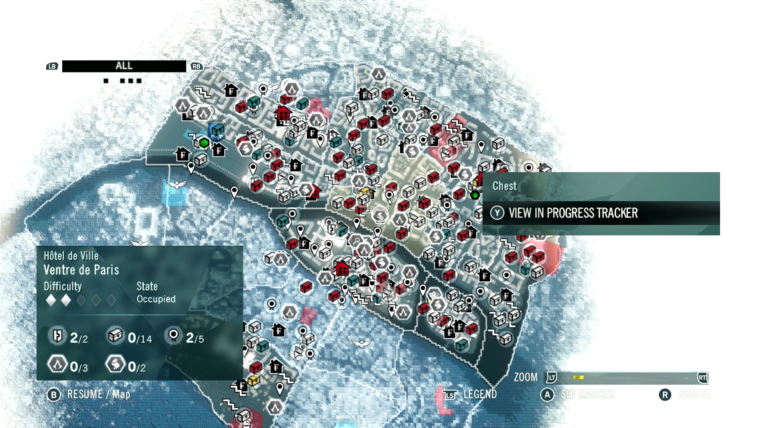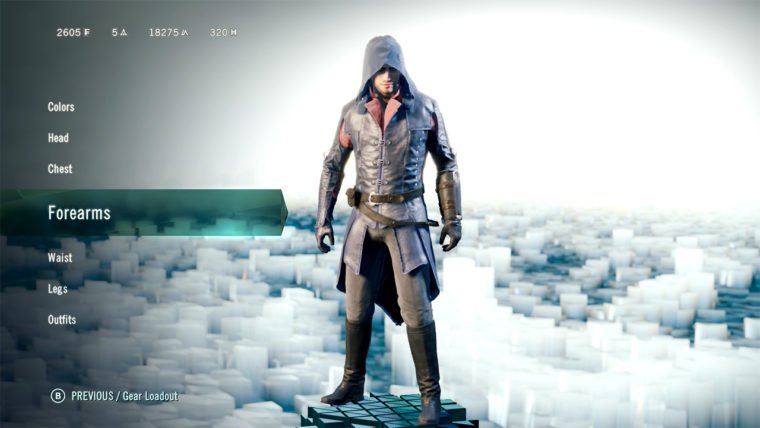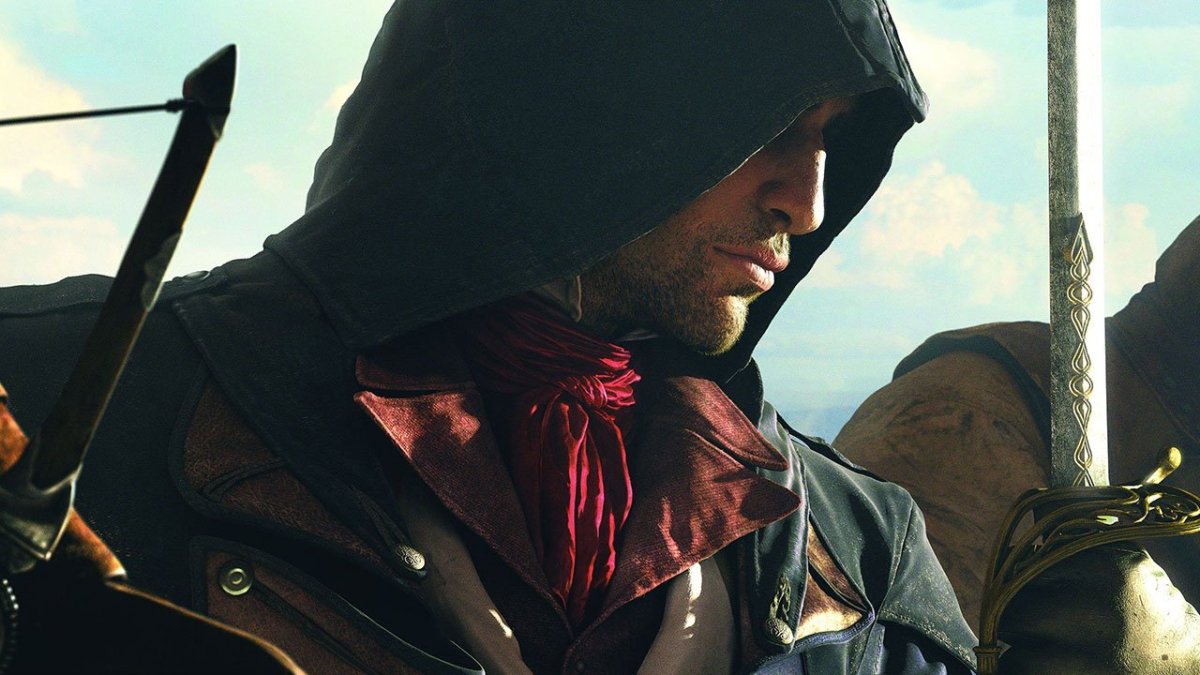Assassin’s Creed Unity isn’t the first game in the series to grace the new Xbox One and PlayStation 4, but it is the first one to break the constraints that the previous generation hardware limitations placed on the series. Utilizing the new-gen hardware explicitly, Assassin’s Creed: Unity is billed as a bigger, better open-world game than its predecessors. Bigger? Certainly. Better? That’s up for debate as some performance issues and bugs have reared their heads at release. Assassin’s Creed: Unity is indeed a prettier version of what fans of the series have become very familiar with. Though it’s an iteration on a popular formula, cutting the fat in some areas, adding, tweaking and refining in others. While recent releases in the Creed series have introduced new mechanics, like boating in ACIII and Black Flag, Unity stays closer to home, a game that focuses more acutely on the Assassin aspect of Assassin’s Creed, featuring a story more similar to the one found in the introductory tales of Ezio and Altair.
There’s no game changing mechanic in Assassin’s Creed Unity, nor big new idea similar to those that have been introduced in more recent Assassin’s Creed games. Assassin’s Creed: Unity is a beautiful game that gets back to basics for the series, doing what it does best, letting you loose in the open world putting your assassin’s skills to the test.
Assassin’s Creed: Unity is set in France in the late-1700’s, a time-period which coincides with the French Revolution. You are introduced to Arno Dorian, son of an Assassin at the center of the Templar vs. Assassin war. As a child, Arno’s father is brutally murdered, he’s taken in and raised by a Templar. When his Templar guardian is slain years later, Arno joins the Parisian Brotherhood of Assassins to track down his murderer, while discovering his own lineage along the way. Unity is a murder mystery of sorts, a story that paints a broad, wide sweeping picture of a bunch of new characters in a new branch of the overarching plot of the Templars vs. Assassins storyline. Unity’s story is entirely what fans of the series expect at this point. We’ve been down the road of welcoming new characters, seen their entire storylines play out, and begin anew with others. This is yet another new chapter, though one that actually has a more fulfilling conclusion and set-up than previous games.
Massive Crowds in Assassin’s Creed Unity
As for the locale, Paris is an absolute marvel. The sprawling open world is the best looking game that Ubisoft has ever created, and indeed lives up to the hype in terms of visuals. Being that this is the first Assassin’s Creed game to be developed for the Xbox One and PlayStation 4, the game was expected to be a big leap from previous games and it is. Unity is a significant step forward from the current-gen versions of Black Flag. While it’s not as colorful a game in general; lighting, character models, and the scope of the game are undeniably more advanced than those previously seen in the series. The setting of the French Revolution gives the massive city a life-like quality, and that’s largely attributable to the sheer number of NPC characters on screen at one time. Unity is an ambitious game, one that seemingly pushes the Xbox One and PS4 to their technical limits, and it shows at times. Eyes adjusted to the eye-popping visuals, players on both the Xbox One and PlayStation 4 versions of the game are going to encounter frame rate issues, plenty of NPC clipping, and a healthy does of texture pop-in at times. These issues are a fact of life with Unity at this point, and it’s unclear if a patch is going to remedy these glitches down the line. Hopefully it does, as some issues, like falling through the map to your death are pretty game breaking. Though it only happened once, it’s clear that there are some things that are in need of a patch.
Assassin’s Creed Unity Rift
The main feature of Unity is certainly the impressive visuals, and it doesn’t have a bad story to boot, but that’s not to say that Ubisoft hasn’t refined other elements of the game. Assassination missions where Arno is tasked with taking down a target to gather information about this mystery is the meat and potatoes of Unity, it’s also something that we’ve seen in other games in the series. Though Unity gives the player a lot of freedom to explore many optional ways to get these tasks done. Players can set-up unique assassination events, use distractions, or just go off the cuff and play without taking any guidance from the game at all. Unity’s main storyline is mostly these Sandbox missions, and it’s refreshing. Instead of a main campaign littered with pointless content, Unity keeps players engaged in the story by having you doing the fun stuff more often than not.
Heading off the story path is necessary though, and there’s a ton of content in Unity. Difficulty increases as you move along the 12 Sequence mystery, and players will actually need to improve their character to better their odds of surviving these missions. Paris is huge though, and each district is filled with things to do, rewards to be earned, chests to unlock, points to synchronize, as well as cooperative missions, heists, and riddles to solve, all which push your character to higher levels, capable of more.

Ubisoft Montreal has also obviously taken feedback into consideration about the core gameplay of the Assassin’s Creed games. A number of changes have been made to the traversal system, which makes completing all of these missions a seemingly more enjoyable experience. It’s not always the case. Things like a simple up and down mechanic has been added to the Free Running system, which helps a lot. Players can also descend from elevated positions more quickly. And a stealth system, complete with a cover switching mechanic (a la Splinter Cell) has been integrated as well. Putting them altogether, and you’ll need to on many missions, and Unity feels more well rounded, more like an actual stealth game than any of the Assassin’s Creed games before it.
There’s a lot to do in Assassin’s Creed Unity

Unity definitely brings forth more stealth elements than the other games, but it’s still a game where you can gets your hands dirty. Combat is largely the same as previous entries. Sword and gunplay are more graphic though. Parrying and dodging are required skills now, and the major difference seems to be the challenge that trying to tackle multiple enemies with different fighting styles brings. Some are more adept swordfighters. Some have brutish strength that will knock you to the ground. Some will throw multiple attacks consecutively, while others will easily be countered. It’s easier to be outnumbered in Assassin’s Creed Unity than it has been in previous games in the series, where enemies will attack you relentlessly and aren’t just waiting patiently to attack you. Sometimes, the best option is running.

It really depends on how much of the side content you focus on, as to how difficult the end game will be. The more character customization points or money that you earn, the better you’ll do. Simply put, there’s a reason not to rush through the main storyline and it’s clear that Ubisoft doesn’t want you to either. They want players engage in renovating properties throughout the city, earning revenue as they do. Then putting that revenue towards any of the many pieces of customizable gear that improves different attributes of your character, making you stronger. It’s an entirely new system in Unity with the many customization options that players have. This gives a lot of reason to complete many different types of missions and their side objectives, as doing so will earn and unlock unique gear. This customization effort is fairly robust for a first time out. Skills points earned can be used towards building your character how you see fit, giving Arno different abilities in the Melee, Ranged, Stealth, and Health categories. While money earned must be managed between staying stocked with supplies for using in-mission, and buying new gear for your character. Hoodies, Jackets, Belts, Bracers and other items are all customizable, and can be mixed and matched at your discretion. It’s simply the deepest customization that we’ve seen in the series.
And why not? It makes a lot of sense. Having ditched the multiplayer features that were introduced in Brotherhood, players are going to need to have unique appearances for the cooperative experience. This four player cooperative action plays out exactly how it would in the single player story, you’re just working with other online players to complete objectives, which tie back in to the single player storyline, and re-enforce the notion that Arno is part of a brotherhood, and not the only Assassin in Paris. Co-op is indeed fun, but like many game modes of this type, having the right team and communicating well is paramount. Alerting guards and making missteps can bring a mission to a crashing halt. Ubisoft gives players the tools to work with players that work well with you. Players can join Cooperative Clubs, which reward participants with unique items and bonuses. There a quite a few cooperative missions to play through, and like much of the sandbox content in Unity, there are a number of ways to tackle them, so replay value is pretty high.
The Verdict
Assassin’s Creed Unity is, at times, a fairly impressive entry in the series. The story is more developed than previous Assassin’s Creed games, and the unfolding mystery is a great catalyst for pushing players through the many assassination scenarios that the game throws at them. It’s just often that you find things not working as expected. Whether it be the hit and miss traversal elements or the graphical bugs, there’s always something that is breaking the immersion. Unity isn’t a bad game by any means, but one that feels a little rough around the edges in some of the new features and their implementation. While hardcore Creed fans can likely overlook some of these issues, those looking for a pitch perfect experience are going to have plenty to gripe at.








Published: Nov 11, 2014 11:00 am